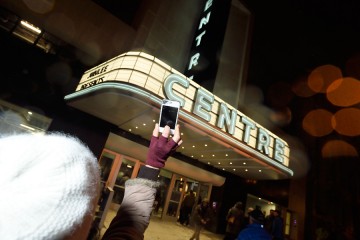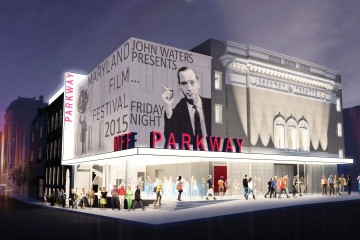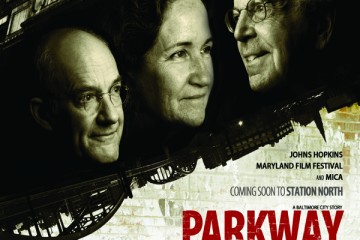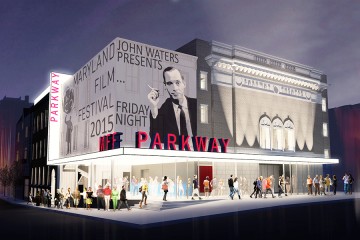The red carpet. The marquee. The photo ops with film and television celebs.
It was a lot like Hollywood, but much more conveniently located—just south of Johns Hopkins University's Homewood campus, at the corner of Charles Street and North Avenue.
Baltimore's film community turned out there Thursday night to light up a long-dark historic movie palace, the 102-year-old Parkway Theatre, known now as the Stavros Niarchos Foundation Parkway.
With a renewed two-tier, 414-seat main auditorium; two new 84-seat screening rooms; and state-of-the-art projection and sound, the Parkway will be the home of the Maryland Film Festival each May. It will also present the film festival's year-round program of indie, international, documentary, classic, and cult films.
"The roughly 150 theaters that dotted the Baltimore landscape during World War II are gone," said Johns Hopkins University President Ronald J. Daniels, prime mover behind the university's involvement in the project and in North Avenue corridor renewal. "I've come to terms with the fact that we no longer require hundreds of theaters. But we do need a few great ones."
Tucked into the cineplex—the original theater building and two adjacent structures—are typical amenities: a popcorn and concessions area, a café, and two lounges.

Image caption: JHU President Ronald J. Daniels and his wife, Joanne Rosen, attend Thursday's event at the Parkway Theater in the Station North Arts and Entertainment District.
Image credit: Will Kirk / Johns Hopkins University
But there is also seminar space for film students from MICA and Johns Hopkins. The higher education institutions share their own Film Centre just down North Avenue; they were among the film festival's partners in an $18.5 million Parkway rehab project designed to add to the growing vitality of Baltimore's Station North Arts and Entertainment District.
Daniels, a member of the Maryland Film Festival board, and festival director Jed Dietz honored the Stavros Niarchos Foundation, an Athens-based international funder supporting arts and culture, education, health and sports, and social welfare. The SNF's $5 million grant was the lead gift to the project.
"The Parkway represents an important opportunity to enhance Baltimore's developing role as a creative hub, and will bring a landmark back to the community," said Andreas Dracopoulos, co-president of the foundation, adding that the project was a "beacon of hope" and an example of the "power of urban renewal" delivered through art and education. "We are proud to support this historic renovation project."
The "First Look" event gave about 200 donors and supporters early access to a space where construction crews had been hard at work as late as Thursday morning. Emcee for the evening was Baltimore's John Waters, writer/director of nearly 20 films, including Mondo Trasho, Pink Flamingos, and Serial Mom. He was also the man behind one Broadway and two cinematic versions of Hairspray.
"This is going to be great for the city, great for downtown," Waters said. "It's going to be great for the next kid from Pigtown or somewhere who's going to make his film" and show it at the Parkway.
Also see
Writer, producer, and Baltimorean David Simon—the creative force behind Homicide: Life on the Street, The Corner, The Wire, Treme, and other acclaimed projects—was also on hand. Ramona Diaz, Johns Hopkins faculty member Matt Porterfield, and JHU Film and Media Studies graduate student Ellie Na Yung Park represented a new generation of Baltimore filmmakers.
The terra cotta and beige brick Parkway, designed with elements of Beaux-Arts and Italian Renaissance architecture, was modeled on London's West End Theater and New York's The Strand. It opened Oct. 23, 1915, showing Zara, starring Pauline Frederick.
It was remodeled in 1926 and 1939, the film festival says, and over the years was also used as a location for radio shows featuring organ music and poetry. In 1956, it became an art house renamed the Five West Art Theatre. The theater closed in 1978.
The renovation was not a restoration; it intentionally didn't return the decorative plaster on the Parkway's balcony, its elaborate ceiling artwork, or wood latticework to the full glory of its 1915 opening night. The vision instead was to combine 21st century film technology with a peek back through the theater's history—scarred walls and all—at all that has happened there in 102 years.
The public gets its first look inside the Stavros Niarchos Foundation Parkway when the 19th Maryland Film Festival opens May 3. Year-round programming begins May 12.
Posted in University News, Community
Tagged community, station north, parkway theatre












